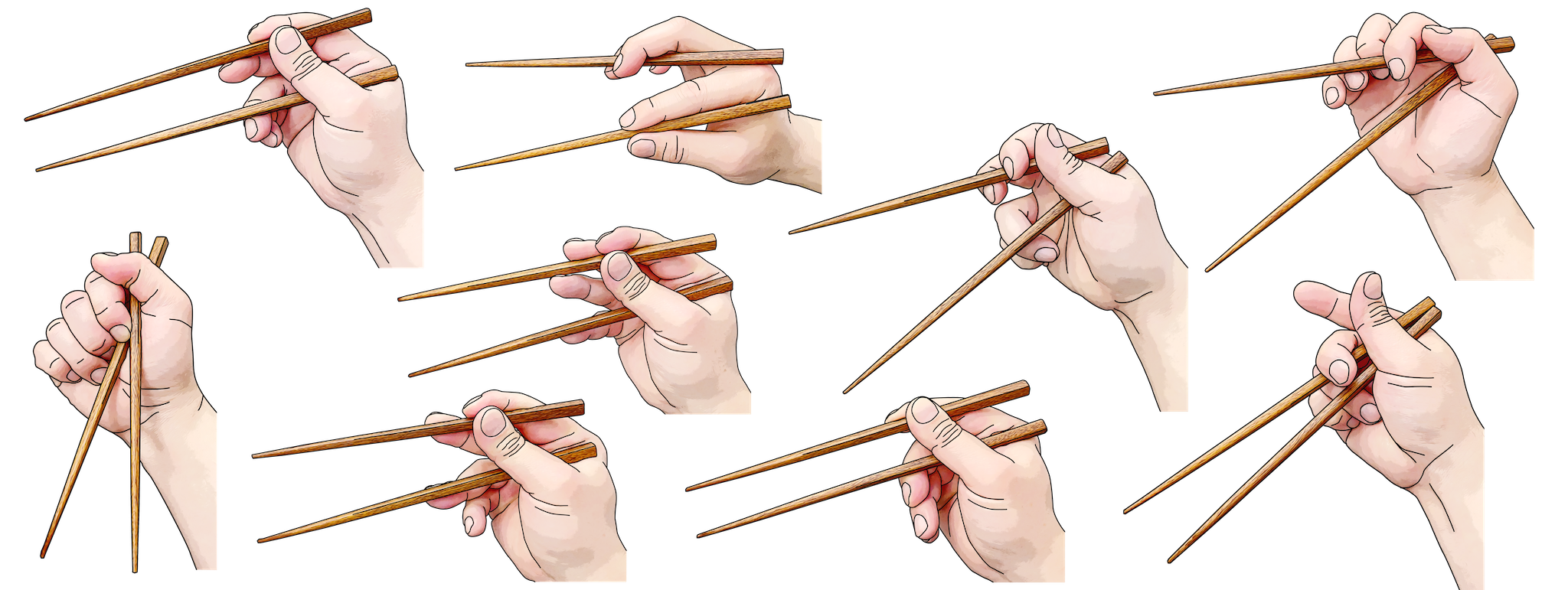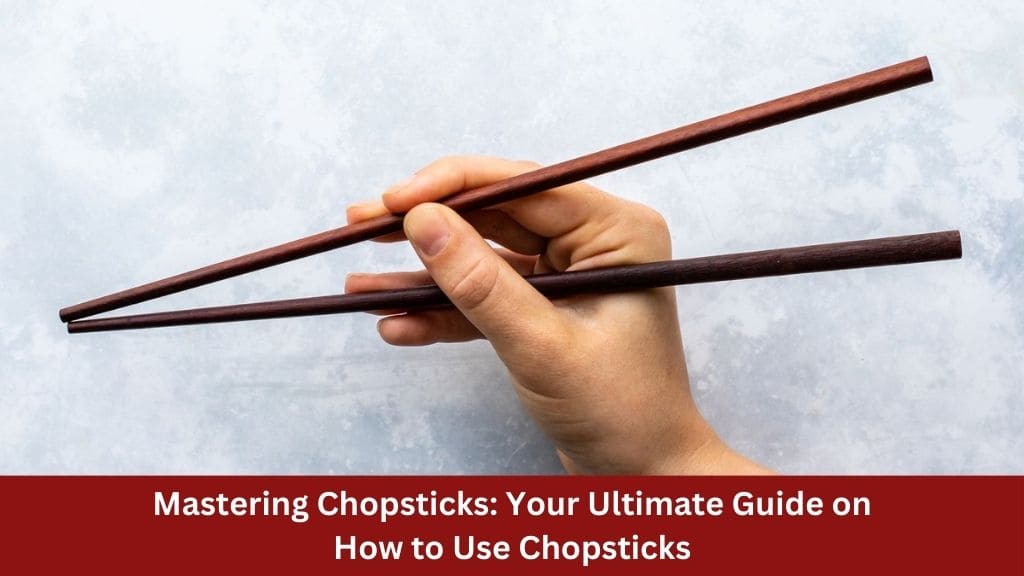In a world filled with culinary diversity, mastering the use of chopsticks is akin to unlocking a new level of dining experience. While initially daunting, learning this traditional utensil can elevate your enjoyment of Asian cuisine and impress your dining companions. Whether you’re a novice or seeking to refine your skills, this comprehensive guide will walk you through the intricacies of using chopsticks with finesse.
Understanding the Basics
What are Chopsticks?
Chopsticks are slender, elongated utensils traditionally used in Asian cultures for eating. Typically made from bamboo, wood, metal, or plastic, they consist of two sticks of equal length.
Cultural Significance
Chopsticks hold deep cultural significance in many Asian countries, symbolizing grace, dexterity, and respect for food. Mastering their use demonstrates appreciation for tradition and cultural etiquette.
Getting Started: The Fundamentals
Before delving into the intricacies of using chopsticks, it’s crucial to grasp the foundational aspects that form the basis of proficiency. Mastering these fundamental principles will set the stage for a smoother learning journey and pave the way for advanced techniques.
Holding Chopsticks Correctly
The proper grip is essential for effective manipulation of chopsticks. Follow these steps to ensure you’re holding them correctly:
- The Writing Grip: Hold the first chopstick between your thumb, index, and middle fingers. Imagine you’re holding a pencil or a paintbrush. Position the chopstick about one-third of the way down from its pointed end, allowing for optimal control and flexibility.
- Placement of the Second Chopstick: Once you have a firm grasp of the first chopstick, position the second one between your index finger and thumb, with the pointed end extending slightly beyond the first chopstick. Use your ring finger to support the second chopstick, ensuring stability and balance.
Practice Makes Perfect
Learning to use chopsticks effectively requires patience, dedication, and consistent practice. Here’s how you can approach the learning process:
- Patience and Persistence: Understand that mastering chopsticks is a gradual process that may require time and effort. Be patient with yourself and celebrate small victories along the way.
- Use of Tools: If you’re new to using chopsticks, consider using training chopsticks or placing a rubber band around the top ends of the chopsticks to keep them aligned. These tools can provide additional support and stability as you familiarize yourself with the movements.
- Start Simple: Begin by practicing basic movements, such as picking up small pieces of food like rice or vegetables. Focus on developing a comfortable grip and refining your control over the chopsticks.
- Consistent Practice: Dedicate regular practice sessions to honing your chopstick skills. Set aside a few minutes each day to engage in focused practice, gradually increasing the complexity of the tasks as you become more proficient.
By mastering the fundamentals of holding chopsticks correctly and embracing a structured approach to practice, you’ll build a solid foundation for advancing your skills and exploring more advanced techniques with confidence and ease. Remember, patience and persistence are key as you embark on your journey to chopstick mastery.
Refining Your Technique
Once you’ve grasped the basics of holding chopsticks correctly, it’s time to refine your technique and hone your skills for more precise and effortless manipulation. Refining your chopstick technique involves focusing on articulating movements, enhancing dexterity, and practicing advanced maneuvers.
Mastering the Articulation
Articulating movements involves mastering the coordination and control required to manipulate chopsticks with finesse. Here’s how you can refine this aspect of your technique:
- Focused Movement: Concentrate on articulating the top chopstick to grasp food while keeping the bottom chopstick stable. This requires precise movements and a delicate touch to ensure that you can pick up food items smoothly and efficiently.
- Practice Control: Engage in exercises that emphasize control over individual chopstick movements. Start by picking up small objects such as beans or grains, gradually increasing the difficulty by moving on to larger or more irregularly shaped items.
- Experiment with Angles: Explore different angles and approaches to gripping and manipulating chopsticks. Experimenting with various techniques will help you find the method that feels most comfortable and effective for you.
Enhancing Dexterity
Dexterity plays a crucial role in mastering chopstick technique, allowing you to manipulate them with agility and precision. Here are some strategies for enhancing your dexterity:
- Fine-Tune Motor Skills: Practice manipulating chopsticks to pick up various shapes and sizes of food, focusing on developing nimble fingers and precise movements. Start with simple exercises and gradually increase the complexity as your skills improve.
- Finger Exercises: Incorporate finger exercises into your practice routine to strengthen the muscles and improve flexibility in your hands and fingers. Simple activities such as squeezing stress balls or using hand grippers can help enhance dexterity and coordination.
- Utilize Props: Experiment with using different props or tools to challenge your dexterity and coordination. For example, try picking up objects of varying sizes or weights using chopsticks, or engage in activities that require precise hand-eye coordination.
Advanced Skills and Techniques
As you become more proficient in using chopsticks, you can explore advanced skills and techniques to further refine your technique and impress your dining companions:
- Speed and Efficiency: Aim to increase your speed and efficiency in picking up food, transitioning seamlessly between bites. Practice moving swiftly and confidently while maintaining control over the chopsticks.
- Advanced Maneuvers: Experiment with advanced maneuvers such as flipping, twirling, or even catching objects mid-air with chopsticks. These techniques not only demonstrate mastery but also add flair and excitement to your dining experience.
By focusing on refining your technique, enhancing dexterity, and exploring advanced skills and techniques, you’ll elevate your chopstick proficiency to new heights. Remember to practice regularly and maintain patience and persistence as you continue on your journey toward chopstick mastery.
Advanced Skills and Techniques

Once you’ve mastered the fundamentals and refined your technique, you can explore advanced skills and techniques to further enhance your chopstick proficiency. These advanced maneuvers not only showcase your mastery but also add an element of flair and excitement to your dining experience.
Speed and Efficiency
Aiming for increased speed and efficiency in using chopsticks not only demonstrates proficiency but also allows you to enjoy your meal with greater ease and fluidity. Here’s how you can enhance your speed and efficiency:
- Practice Regularly: Dedicate time to regular practice sessions focused on improving your speed and efficiency in picking up food with chopsticks. Start with simple movements and gradually increase the pace as you become more comfortable.
- Focus on Fluid Movements: Emphasize smooth and fluid movements when using chopsticks, minimizing unnecessary pauses or adjustments. Practice transitioning seamlessly between picking up food items and bringing them to your mouth.
- Develop Muscle Memory: Engage in repetitive exercises to develop muscle memory and familiarize yourself with the movements required for efficient chopstick use. Over time, these movements will become more automatic, allowing you to pick up food with ease and precision.
Advanced Maneuvers
Exploring advanced maneuvers adds an element of excitement and challenge to your chopstick skills. While these techniques may require additional practice and coordination, they can elevate your dining experience to new heights. Here are some advanced maneuvers to try:
- Flipping: Master the art of flipping food items using chopsticks, such as flipping sushi rolls or dumplings to ensure even seasoning or presentation. Practice flipping with precision to avoid dropping or mishandling the food.
- Twirling: Experiment with twirling chopsticks between your fingers in a controlled manner, adding a playful touch to your dining experience. Twirling chopsticks can also serve as a stylish and impressive gesture when dining with others.
- Mid-Air Catch: Challenge yourself by attempting to catch food items mid-air with chopsticks. Start with larger, easy-to-grasp items such as grapes or small candies, gradually progressing to smaller and more challenging targets. This advanced maneuver requires quick reflexes and precise hand-eye coordination.
Cultural Etiquette
While mastering advanced chopstick skills is undoubtedly impressive, it’s essential to remember the cultural significance and etiquette associated with their use:
- Respectful Dining Practices: Adhere to cultural norms and etiquette when using chopsticks, such as avoiding pointing them directly at others or using them to stab or spear food. Handle chopsticks with care and respect, recognizing their significance in Asian cultures.
- Appreciation for Tradition: View the mastery of chopstick skills as an opportunity to deepen your appreciation for cultural traditions and customs. Embrace the cultural significance of chopsticks and approach their use with reverence and respect.
By exploring advanced skills and techniques with chopsticks, you can not only enhance your dining experience but also showcase your dedication to mastering this traditional utensil. Remember to practice regularly, maintain patience and persistence, and always approach chopstick use with cultural sensitivity and respect.
Embracing the Journey
Learning to use chopsticks is not merely about acquiring a new skill—it’s a journey that encompasses cultural exploration, personal growth, and the joy of culinary discovery. Embracing this journey involves more than just mastering the physical technique; it’s about immersing yourself in a rich tapestry of tradition, fostering a deeper appreciation for diverse cuisines, and sharing the experience with others.
Culinary Exploration
Using chopsticks opens the door to a world of culinary delights, allowing you to explore the vibrant and diverse flavors of Asian cuisine. As you embark on this culinary journey, consider the following:
- Try New Foods: Use chopsticks as a tool for culinary adventure, sampling a wide array of dishes from different Asian cultures. Experiment with flavors, textures, and ingredients to expand your palate and discover new favorites.
- Cultural Appreciation: Approach each meal with a sense of curiosity and respect for the cultural heritage behind the food. Learn about the origins and traditions associated with various dishes, deepening your understanding and appreciation of different culinary traditions.
Personal Growth
Learning to use chopsticks is a journey of personal growth and self-improvement, requiring patience, persistence, and a willingness to step outside your comfort zone. Here’s how you can embrace this journey:
- Challenge Yourself: View the process of learning to use chopsticks as an opportunity for personal challenge and growth. Set goals for yourself, whether it’s mastering a particular technique or trying a new type of cuisine, and celebrate your progress along the way.
- Learn from Mistakes: Understand that making mistakes is a natural part of the learning process. Instead of becoming discouraged by setbacks, use them as learning opportunities to refine your technique and improve your skills.
Sharing the Experience
One of the most rewarding aspects of mastering chopsticks is the opportunity to share the experience with others, fostering connections and creating lasting memories. Consider the following ways to share the joy of using chopsticks with friends and family:
- Bonding Over Food: Gather friends and family for a shared dining experience centered around using chopsticks. Encourage laughter, conversation, and camaraderie as you navigate the challenges and triumphs of mastering this traditional utensil together.
- Teach Others: Share your knowledge and skills with others who may be less familiar with using chopsticks. Offer guidance, encouragement, and practical tips to help them overcome obstacles and enjoy the experience of learning something new.
Embracing the journey of learning to use chopsticks is about more than just mastering a culinary technique—it’s a celebration of cultural diversity, personal growth, and shared experiences. By approaching the process with an open mind, a sense of curiosity, and a spirit of camaraderie, you can enrich your dining experiences, deepen your appreciation for cultural traditions, and create meaningful connections with those around you. So, savor each moment, embrace the challenges, and enjoy the delicious rewards that come with mastering the art of using chopsticks.
Conclusion
Mastering the art of using chopsticks is not merely about picking up food—it’s about embracing a cultural tradition, refining dexterity, and enhancing dining experiences. By understanding the fundamentals, refining techniques, and embracing the journey, anyone can become proficient in using chopsticks and unlock a world of culinary delights. So, grab your chopsticks, embark on this culinary adventure, and savor the flavors of tradition and innovation with every bite.





